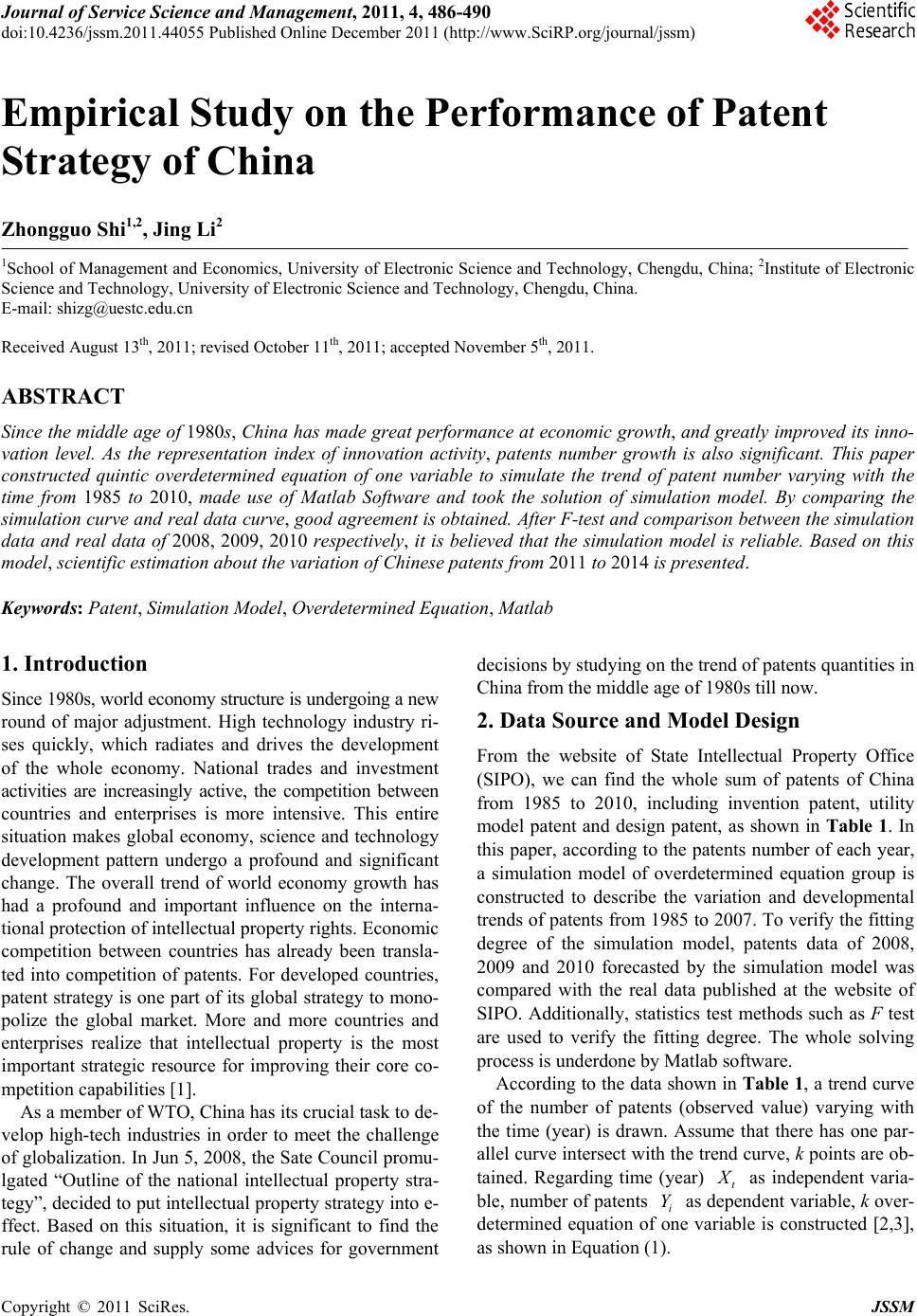
Journal of Service Science and Management, 2011, 4, 486-490
doi:10.4236/jssm.2011.44055 Published Online December 2011 (http://www.SciRP.org/journal/jssm)
Copyright © 2011 SciRes. JSSM
Empirical Study on the Performance of Patent
Strategy of China
Zhongguo Shi1,2, Jing Li2
1School of Management and Economics, University of Electronic Science and Technology, Chengdu, China; 2Institute of Electronic
Science and Technology, University of Electronic Science and Technology, Chengdu, China.
E-mail: shizg@uestc.edu.cn
Received August 13th, 2011; revised October 11th, 2011; accepted November 5th, 2011.
ABSTRACT
Since the middle age of 1980s, China has made great performance at economic growth, and greatly improved its inn o-
vation level. As the representation index of innovation activity, patents number growth is also significant. This paper
constructed quintic overdetermined equation of one variable to simulate the trend of patent number varying with the
time from 1985 to 2010, made use of Matlab Software and took the solution of simulation model. By comparing the
simulation curve and rea l data curve, good agreement is obta ined. After F-test and compa rison between the simu lation
data and real data of 2008, 2009, 2010 respectively, it is believed that the simulation model is reliable. Based on this
model, scientific estimation about the variation of Chinese patents from 2011 to 2014 is presented.
Keywords: Patent, Simulation Model, Overdetermined Equation, Ma tlab
1. Introduction
Since 1980s, world economy structure is undergoing a new
round of major adjustment. High technology industry ri-
ses quickly, which radiates and drives the development
of the whole economy. National trades and investment
activities are increasingly active, the competition between
countries and enterprises is more intensive. This entire
situation makes global economy, science and technology
development pattern undergo a profound and significant
change. The overall trend of world economy growth has
had a profound and important influence on the interna-
tional protection of intellectual property rights. Economic
competition between countries has already been transla-
ted into competition of patents. For developed countries,
patent strategy is one part of its global strategy to mono-
polize the global market. More and more countries and
enterprises realize that intellectual property is the most
important strategic resource for improving their core co-
mpetition capabilities [1 ].
As a member of WTO, China has its crucial task to de-
velop high-tech industries in order to meet the challenge
of globalization. In Jun 5, 2008, the Sate Council promu-
lgated “Outline of the national intellectual property stra-
tegy”, decided to put intellectual property strategy into e-
ffect. Based on this situation, it is significant to find the
rule of change and supply some advices for government
decisions by studying on the trend of paten ts qu antities in
China from the middle age of 1980s till now.
2. Data Source and Model Design
From the website of State Intellectual Property Office
(SIPO), we can find the whole sum of patents of China
from 1985 to 2010, including invention patent, utility
model patent and design patent, as shown in Table 1. In
this paper, according to the patents number of each year,
a simulation model of overdetermined equation group is
constructed to describe the variation and developmental
trends of patents from 1985 to 2007. To verify the fitting
degree of the simulation model, patents data of 2008,
2009 and 2010 forecasted by the simulation model was
compared with the real data published at the website of
SIPO. Additionally, statistics test methods such as F test
are used to verify the fitting degree. The whole solving
process is underdone by Matlab software.
According to the data shown in Table 1, a trend curve
of the number of patents (observed value) varying with
the time (year) is drawn. Assume that there has one par-
allel curve intersect with the trend curve, k points are ob-
tained. Regarding time (year) t
as independent varia-
ble, number of patents i as dependent variable, k over-
determined equation of one variable is constructed [2,3],
as shown in Equation (1).
Y